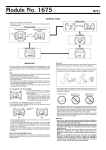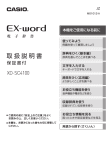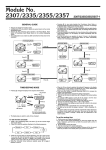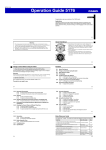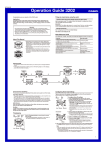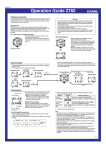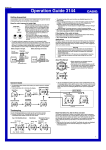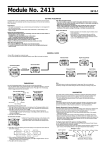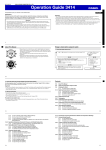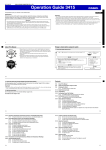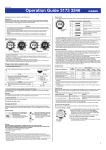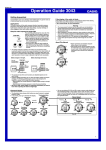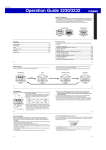Download Casio MO1012-EA User's Manual
Transcript
MO1012-EA Operation Guide 3255 ENGLISH Congratulations upon your selection of this CASIO watch. Applications The built-in sensors of this watch measure barometric pressure, temperature and altitude. Measured values are then shown on the display. Such features make this watch useful when hiking, mountain climbing, or when engaging in other such outdoor activities. E-1 Warning ! • The measurement functions built into this watch are not intended for taking measurements that require professional or industrial precision. Values produced by this watch should be considered as reasonable representations only. • Note that CASIO COMPUTER CO., LTD. assumes no responsibility for any damage or loss suffered by you or any third party arising through the use of this product or its malfunction. About This Manual • Depending on the model of your watch, display text appears either as dark figures on a light background, or light figures on a dark background. All sample displays in this manual are shown using dark figures on a light background. • Button operations are indicated using the letters shown in the illustration. • Note that the product illustrations in this manual are intended for reference only, and so the actual product may appear somewhat different than depicted by an illustration. E-2 Things to check before using the watch 1. Check the Home City and the daylight saving time (DST) setting. Use the procedure under “To configure Home City settings” (page E-14) to configure your Home City and daylight saving time settings. Important! Proper World Time Mode data depends on correct Home City, time, and date settings in the Timekeeping Mode. Make sure you configure these settings correctly. 2. Set the current time. See “Configuring Current Time and Date Settings” (page E-17). The watch is now ready for use. E-3 Contents E-3 About This Manual E-4 Things to check before using the watch E-9 Mode Reference Guide E-13 Timekeeping E-14 Configuring Home City Settings E-14 To configure Home City settings E-16 To change the Daylight Saving Time (summer time) setting E-17 Configuring Current Time and Date Settings E-17 To change the current time and date settings E-21 Barometer/Thermometer E-21 To enter and exit the Barometer/Thermometer Mode E-26 To calibrate the pressure sensor and the temperature sensor E-4 E-28 Altimeter E-29 To take an altimeter reading E-32 To specify a reference altitude value E-37 Specifying Temperature, Barometric Pressure, and Altitude Units E-37 To specify temperature, barometric pressure, and altitude units E-39 Precautions Concerning Simultaneous Measurement of Altitude and Temperature E-40 Checking the Current Time in a Different Time Zone E-40 To enter the World Time Mode E-40 To view the time in another time zone E-41 To specify standard time or daylight saving time (DST) for a city E-6 E-5 E-42 Using the Stopwatch E-42 To enter the Stopwatch Mode E-42 To perform an elapsed time operation E-42 To pause at a split time E-43 To measure two finishes E-44 Using the Countdown Timer E-44 To enter the Countdown Timer Mode E-44 To specify the countdown start time E-46 To perform a countdown timer operation E-46 To stop the alarm E-47 Using the Alarm E-47 To enter the Alarm Mode E-48 To set an alarm time E-49 To test the alarm E-50 To turn an alarm and the Hourly Time Signal on and off E-50 To stop the alarm E-51 Illumination E-51 To turn on illumination E-51 To change the illumination duration Mode Reference Guide E-53 Button Operation Tone E-53 To turn the button operation tone on and off To do this: • View the current time and date in the Home City • Configure Home City and daylight saving time (DST) settings • Configure time and date settings View the barometric pressure and temperature at your current location • View the altitude at your current location • Determine the altitude differential between two locations (reference point and current location) View the current time in one of 48 cities (31 time zones) around the globe Use the stopwatch to measure elapsed time Use the countdown timer Set an alarm time E-55 Troubleshooting E-59 Specifications E-8 E-7 Your watch has 7 “modes”. The mode you should select depends on what you want to do. Enter this mode: See: Timekeeping Mode E-13 Barometer/ Thermometer Mode E-21 Altimeter Mode E-28 World Time Mode E-40 Stopwatch Mode Countdown Timer Mode Alarm Mode E-42 E-44 E-47 E-9 Operation Guide 3255 Selecting a Mode • The illustration below shows which buttons you need to press to navigate between modes. • In any mode (except when a setting screen, with flashing digits is on the display), press D to illuminate the display. Timekeeping Mode Altimeter Mode Barometer/ Thermometer Mode World Time Mode Countdown Timer Mode Stopwatch Mode Alarm Mode E-10 E-11 General Functions (All Modes) The functions and operations described in this section can be used in all of the modes. Timekeeping Auto Return Features • The watch returns to the Timekeeping Mode automatically if you do not perform any button operation for two or three minutes in the Alarm Mode. • The watch will return to the Timekeeping Mode automatically if you do not perform any operation for about one hour after entering the Barometer/Thermometer Mode. • If you leave a setting screen with flashing digits on the display for two or three minutes without performing any operation, the watch exits the setting screen automatically. Graphic PM indicator Day of week Month Day Use the Timekeeping Mode to set and view the current time and date. • In the Timekeeping Mode, the graphic in the upper right corner of the display indicates the passage of seconds. Initial Screens When you enter the World Time Mode or Alarm Mode, the data you were viewing when you last exited the mode appears first. Scrolling The C and D buttons are used on the setting screen to scroll through data on the display. In most cases, holding down these buttons during a scroll operation scrolls through the data at high speed. Hour : Minutes Seconds E-12 E-13 Configuring Home City Settings 2. Press C (East) and D (West) to select the city code you want to use as your Home City. • Keep pressing C or D until the city code you want to select as your Home City appears on the display. DST indicator There are two Home City settings: actually selecting the Home City and selecting either standard time or daylight saving time (DST). PM indicator City code Hour : Minutes Seconds To configure Home City settings 1. In the Timekeeping Mode, hold down A until the currently selected city code (Home City) starts to flash. This is the city code setting screen. • Before the city code starts to flash, the message SET Hold will appear on the display. Keep A depressed until SET Hold disappears and the city code starts to flash. • The watch will exit the setting mode automatically if you do not perform any operation for about two or three minutes. • For details about city codes, see the “City Code Table” at the back of this manual. E-14 3. Press B to display the DST setting screen. 4. Press C to toggle between Daylight Saving Time (On) and Standard Time (OFF). • Note that you cannot switch between standard time and daylight saving time (DST) while UTC is selected as your Home City. Setting 5. After all the settings are the way you want, press A to return to the Timekeeping Mode. • The DST indicator appears to indicate that Daylight Saving Time is turned on. Note • After you specify a city code, the watch will use UTC* offsets in the World Time Mode to calculate the current time for other time zones based on the current time in your Home City. * Coordinated Universal Time, the world-wide scientific standard of timekeeping. The reference point for UTC is Greenwich, England. E-15 To change the Daylight Saving Time (summer time) setting 1. In the Timekeeping Mode, hold down A until the DST indicator currently selected city code (Home City) starts to flash. This is the city code setting screen. • Before the city code starts to flash, the message SET Hold will appear on the display. Keep A depressed until SET Hold disappears and the city code starts to flash. 2. Press B to display the DST setting screen. Setting 3. Press C to toggle between Daylight Saving Time (On) and Standard Time (OFF). 4. After all the settings are the way you want, press A to return to the Timekeeping Mode. • The DST indicator appears to indicate that Daylight Saving Time is turned on. Configuring Current Time and Date Settings You can use the procedure below to adjust the current time and date settings if they are off. To change the current time and date settings 1. In the Timekeeping Mode, hold down A until the PM indicator currently selected city code (Home City) starts to flash. This is the city code setting screen. City code • Before the city code starts to flash, the message SET Hold will appear on the display. Keep A depressed until SET Hold disappears and the city code starts to flash. Hour : Minutes Seconds 2. Use C and D to select the city code you want. • Select your Home City code before changing any other setting. • For full information on city codes, see the “City Code Table” at the back of this manual. E-16 E-17 3. Press B to move the flashing in the sequence shown below to select the other settings. City Code DST Barometer unit 12/24-Hour Format Altitude unit Seconds Temperature unit Hour Illumination Duration Minute Year Screen Month Button Operation Tone On/Off 50 To do this: Press C. Reset the seconds to 00 Press C. Change the hour or minute Use C (+) and D (–). Day • The following steps explain how to configure timekeeping settings only. 4. When the timekeeping setting you want to change is flashing, use C and/or D to change it as described below. Screen E-18 To do this: Do this: Toggle between 12-hour (12H) and 24-hour (24H) timekeeping. Do this: Change the city code Use C (East) and D (West). Toggle between Daylight Saving Time (On) and Standard Time (OFF). Press C. Change the year, month, or day 5. Press A to exit the setting screen. E-19 Operation Guide 3255 Note • For information about selecting a Home City and configuring the DST setting, see “Configuring Home City Settings” (page E-14). • While 12-hour format is selected for timekeeping, a P (PM) indicator will appear for times from noon to 11:59 p.m. No indicator appears for times from midnight to 11:59 a.m. With 24-hour format, time is displayed from 0:00 to 23:59, without any P (PM) indicator. • The watch’s built-in full automatic calendar makes allowances for different month lengths and leap years. Once you set the date, there should be no reason to change it except after you have the watch’s battery replaced. Barometer/Thermometer This watch uses a pressure sensor to measure air pressure (barometric pressure) and a temperature sensor to measure temperature. Pressure differential pointer Current time Barometric pressure To enter and exit the Barometer/Thermometer Mode 1. While in the Timekeeping Mode, press B to enter the Barometer/Thermometer Mode. • BARO will appear on the display, indicating that barometric pressure and temperature measurements are in progress. The measurement results will appear on the display after about fi ve seconds. • After you press B, the watch will take readings every fi ve seconds for the first three minutes, and then every two minutes after that. Temperature E-20 E-21 2. Press B five times to return to the Timekeeping Mode. • The watch will return to the Timekeeping Mode automatically if you do not perform any operation for about one hour after entering the Barometer/ Thermometer Mode. Barometric Pressure • Barometric pressure is displayed in units of 1 hPa (or 0.05 inHg). • The displayed barometric pressure value changes to - - - if a measured barometric pressure falls outside the range of 260 hPa to 1,100 hPa (7.65 inHg to 32.45 inHg). The barometric pressure value will reappear as soon as the measured barometric pressure is within the allowable range. Display Units You can select either hectopascals (hPa) or inchesHg (inHg) as the display unit for the measured barometric pressure, and Celsius (°C) or Fahrenheit (°F) as the display unit for the measured temperature value. See “To specify temperature, barometric pressure, and altitude units” (page E-37). Barometric Pressure Differential Pointer Barometric pressure differential pointer This pointer indicates the relative difference between the most recent barometric pressure reading and the current barometric pressure value displayed in the Barometer/ Thermometer Mode (page E-21). Temperature • Temperature is displayed in units of 0.1°C (or 0.2°F). • The displayed temperature value changes to --.- °C (or °F) if a measured temperature falls outside the range of –10.0°C to 60.0°C (14.0°F to 140.0°F). The temperature value will reappear as soon as the measured temperature is within the allowable range. E-22 E-23 Reading Barometric Pressure Differential Pointer Pressure differential is indicated in the range of ±5 hPa, in 1-hPa units. If the pointer is located here: – + Pressure is rising and weather will tend to improve. • The nearby screen shot, for example, shows what the pointer would indicate when the calculated pressure differential is approximately – 3 hPa (approximately –0.09 inHg). Pressure Sensor and Temperature Sensor Calibration inHg values hPa values It means this: Pressure is falling and weather will tend to deteriorate. • Barometric pressure is calculated and displayed using hPa as the standard. The barometric pressure differential also can be read in inHg units as shown in the illustration (1 hPa = 0.03 inHg). Current pressure greater than most recent measured pressure The pressure sensor and temperature sensor built into the watch are calibrated at the factory and normally require no further adjustment. If you notice serious errors in the pressure readings and temperature readings produced by the watch, you can calibrate a sensor to the reading of another device to correct the errors. 0.15 5 0 0 5 5 – –0.1 hPa values inHg values Important! • Incorrectly calibrating the temperature sensor can result in incorrect readings. Carefully read the following before doing anything. – Compare the readings produced by the watch with those of another reliable and accurate thermometer. – If adjustment is required, remove the watch from your wrist and wait for 20 or 30 minutes to give the temperature of the watch time to stabilize. Current pressure less than most recent measured pressure E-24 E-25 To calibrate the pressure sensor and the temperature sensor 1.Take a reading with another measurement device to determine the exact current barometric pressure or temperature. 2. With the watch in the Timekeeping Mode, press B to enter the Barometer/Thermometer Mode. 3. Hold down A until the current temperature value starts to flash on the display. This is the setting screen. • Before the temperature value starts to flash, the message SET Hold will appear on the display. Keep A depressed until SET Hold disappears. 4. Press B to move the flashing between the temperature value and barometric pressure value, to select the one you want to calibrate. 5. Use C (+) and D (–) to adjust the calibration value in the units shown below. Temperature 0.1°C (0.2°F) Barometric Pressure 1 hPa (0.05 inHg) • To return the currently flashing value to its initial factory default setting, press C and D at the same time. OFF will appear at the flashing location for about one second, followed by the initial default value. 6. Press A to return to the Barometer/Thermometer Mode screen. Barometer and Thermometer Precautions • The pressure sensor built into this watch measures changes in air pressure, which you can then apply to your own weather predictions. It is not intended for use as a precision instrument in official weather prediction or reporting applications. • Sudden temperature changes can affect pressure sensor readings. • Temperature measurements are affected by your body temperature (while you are wearing the watch), direct sunlight, and moisture. To achieve a more accurate temperature measurement, remove the watch from your wrist, place it in a well ventilated location out of direct sunlight, and wipe all moisture from the case. It takes approximately 20 to 30 minutes for the case of the watch to reach the actual surrounding temperature. E-26 E-27 Altimeter The watch displays altitude values based on air pressure readings taken by a built-in pressure sensor. How the Altimeter Measures Altitude The altimeter can measure altitude based on its own preset values (initial default method) or using a reference altitude specified by you. • When mountain climbing, you can specify a reference altitude value in accordance with a marker along the way or altitude information from a map. After that, the altitude readings produced by the watch will be more accurate than they would without a reference altitude value. To take an altimeter reading 1. Make sure the watch is in the Timekeeping Mode. Current time When you measure altitude based on preset values Data produced by the watch’s barometric pressure sensor is converted to approximate altitude based on ISA (International Standard Atmosphere) conversion values stored in watch memory. When you measure altitude using a reference altitude specified by you After you specify a reference altitude, the watch uses that value to convert barometric pressure readings to altitude (page E-32). A B Current altitude Temperature E-28 2. Press C to start Altimeter measurement. • ALTI will appear on the display, indicating that Altimeter measurement is in progress. The first reading will appear on the display after about four or fi ve seconds. • The current altitude value is displayed in units of 5 meters (20 feet). • After the first reading is obtained, the watch continues to take altimeter readings automatically every fi ve seconds for the first three minutes, and then every two minutes after that. E-29 Operation Guide 3255 • If you leave the watch in the Altimeter Mode, it will update the displayed altitude value regularly. • Temperature is measured in the Barometer/Thermometer Mode and in the Altimeter Mode. For details about temperature readings, see “Temperature” (page E-22). 3. After you are finished using the Altimeter, press B to return to the Timekeeping Mode and stop auto measurement. • The watch will return to the Timekeeping Mode automatically if you do not perform any operation for about 10 hours after entering the Altimeter Mode. Note • The measurement range for altitude is –700 to 10,000 meters (–2,300 to 32,800 feet). • The displayed altitude value changes to - - - - if an altitude reading falls outside the measurement range. An altitude value will reappear as soon as the altitude reading is within the allowable range. • Normally, displayed altitude values are based on the watch’s preset conversion values. You also can specify a reference altitude value, if you want. See “Specifying a Reference Altitude Value” below. • You can change the unit for displayed altitude values to either meters (m) or feet (ft). See “To specify temperature, barometric pressure, and altitude units” (page E-37). Specifying a Reference Altitude Value The altitude readings produced by this watch are subject to error caused by changes in air pressure. Because of this, we recommend that you update the reference altitude value whenever accurate altitude information is available during your climb. After you specify a reference altitude value, the watch adjusts its air-pressure-to-altitude conversion calculation accordingly. E-30 E-31 To specify a reference altitude value 1. In the Altimeter Mode, hold down A until the current reference altitude value starts to flash. This is the setting screen. • Before the reference altitude value starts to flash, the message SET Hold will appear on the display. Keep A depressed until SET Hold disappears. 2. Press C (+) or D (–) to change the current reference altitude value by 5 meters (or 20 feet). • Specify a reference altitude value based on accurate altitude information about your current location from a map, etc. • You can set the reference altitude value within the range of –10,000 to 10,000 meters (–32,800 to 32,800 feet). • Pressing C and D at the same time returns to OFF (no reference altitude value), so the watch performs air pressure to altitude conversions based on preset data only. How does the altimeter work? Generally, air pressure and temperature decrease as altitude increases. This watch bases its altitude measurements on International Standard Atmosphere (ISA) values stipulated by the International Civil Aviation Organization (ICAO). These values define relationships between altitude, air pressure, and temperature. Altitude 3500 m 3000 m 2500 m 2000 m 1500 m 1000 m 0m Air Pressure 616 hPa 4000 m 500 m 701 hPa About 8 hPa per 100 m About 9 hPa per 100 m Temperature –11°C –4.5°C 795 hPa About 10 hPa per 100 m 2°C 899 hPa About 11 hPa per 100 m 8.5°C 1013 hPa About 12 hPa per 100 m About 6.5°C per 1000 m 15°C 3. Press A to exit the setting screen. E-32 E-33 14000 ft. 12000 ft. 10000 ft. 8000 ft. 6000 ft. 4000 ft. 2000 ft. 0 ft. 19.03 inHg About 0.15 inHg per 200 ft. 16.2°F 22.23 inHg About 0.17 inHg per 200 ft. 30.5°F 25.84 inHg About 0.192 inHg per 200 ft. 44.7°F 29.92 inHg About 0.21 inHg per 200 ft. There are two standard methods of expressing altitude: Absolute altitude and relative altitude. Absolute altitude expresses an absolute height above sea level. Relative altitude expresses the difference between the height of two different places. About 3.6°F per 1000 ft. 59.0°F Source: International Civil Aviation Organization • Note that the following conditions will prevent you from obtaining accurate readings: When air pressure changes because of changes in the weather Extreme temperature changes When the watch itself is subjected to strong impact E-34 Height of building 130 m (relative altitude) Rooftop at an altitude of 230 m above sea level (absolute altitude) Sea Level E-35 Altimeter Precautions Specifying Temperature, Barometric Pressure, and Altitude Units • This watch estimates altitude based on air pressure. This means that altitude readings for the same location may vary if air pressure changes. • The semiconductor pressure sensor used by the watch for altitude measurements is also affected by temperature. When taking altitude measurements, do not subject the watch to temperature changes. • Do not rely upon this watch for altitude measurements or perform button operations while sky diving, hang gliding, or paragliding, while riding a gyrocopter, glider, or any other aircraft, or while engaging in any other activity where there is the chance of sudden altitude changes. • Do not use this watch for measuring altitude in applications that demand professional or industrial level precision. • Remember that the air inside of a commercial aircraft is pressurized. Because of this, the readings produced by this watch will not match the altitude readings announced or indicated the flight crew. E-36 Use the procedure below to specify the temperature, barometric pressure, and altitude units to be used in the Barometer/Thermometer Mode and the Altimeter Mode. Important! When TYO (Tokyo) is selected as the Home City, the altitude unit is set automatically to meters (m), the barometric pressure unit to hectopascals (hPa), and the temperature unit to Celsius (°C). These settings cannot be changed. To specify temperature, barometric pressure, and altitude units 1. In the Timekeeping Mode, hold down A until the currently selected city code starts to flash. This is the city code setting screen. E-37 • Before the city code starts to flash, the message SET Hold will appear on the display. Keep A depressed until SET Hold disappears and the city code starts to flash. 2. Keep pressing B until TEMP (temperature), ALTI (altitude), or BARO (barometric pressure) appears in the upper left corner of the screen. • See step 3 under “To change the current time and date settings” (page E-17) for information about how to scroll through setting screens. 3. Perform the operations below to specify the units you want. To specify this unit: Press this key: To toggle between these settings: Temperature C °C (Celsius) and °F (Fahrenheit) Altitude C m (meters) and ft (feet) Barometric Pressure C hPa (hectopascals) and inHg (inches of mercury) Precautions Concerning Simultaneous Measurement of Altitude and Temperature Though you can perform altitude and temperature measurements at the same time, you should remember that each of these measurements requires different conditions for best results. With temperature measurement, it is best to remove the watch from your wrist in order to eliminate the effects of body heat. In the case of altitude measurement, on the other hand, it is better to leave the watch on your wrist, because doing so keeps the watch at a constant temperature, which contributes to more accurate altitude measurements. • To give altitude measurement priority, leave the watch on your wrist or in any other location where the temperature of the watch is kept constant. • To give temperature measurement priority, remove the watch from your wrist and allow it to hang freely from your bag or in another location where it is not exposed to direct sunlight. Note that removing the watch from your wrist can affect pressure sensor readings momentarily. 4. After the settings are the way you want, press A to exit the setting screen. E-38 E-39 Operation Guide 3255 Checking the Current Time in a Different Time Zone Currently selected World Time City Current Timekeeping Mode time You can use the World Time Mode to view the current time in one of 31 time zones (48 cities) around the globe. The city that is currently selected in the World Time Mode is called the “World Time City”. To enter the World Time Mode Use B to select the World Time Mode (WT) as shown on page E-10. • WT will appear on the display for about one second. Next, the display will change to show the city code of the currently selected World Time City. Current time in the currently selected World Time City To view the time in another time zone In the World Time Mode, use C (East) to scroll through city codes. To specify standard time or daylight saving time (DST) for a city 1. In the World Time Mode, use C (East) to display the city code (time zone) whose Standard Time/Daylight Saving Time setting you want to change. 2. Hold down A until DST Hold appears on the display and then disappears. Release A after DST Hold disappears. • This toggles the city code you selected in step 1 between Daylight Saving Time (DST indicator displayed) and standard time (DST indicator not displayed). DST indicator • You cannot use the World Time Mode to change the current standard time/ daylight saving time (DST) setting of the Home City. • Note that you cannot switch between standard time/daylight saving time (DST) while UTC is selected as the World Time City. • Note that the standard time/daylight saving time (DST) setting affects only the currently selected time zone. Other time zones are not affected. E-40 E-41 Using the Stopwatch To measure two finishes The stopwatch measures elapsed time, split times, and two finishes. C A C A A Start Split First runner finishes. Display time of first runner Stop Second runner finishes. Split release Display time of second runner Reset Current time Hours Seconds To enter the Stopwatch Mode Use B to select the Stopwatch Mode (STW) as shown on page E-10. • STW will appear on the display for about one second. Next, the display will change to show the stopwatch hours. To perform an elapsed time operation Minutes 1/100 second C C C C A Start Stop (Restart) (Stop) Reset A C A To pause at a split time C A Start Split Split release Stop (SPL displayed) E-42 Reset E-43 Using the Countdown Timer The countdown timer can be configured to start at a preset time, and sound an alarm when the end of the countdown is reached. To enter the Countdown Timer Mode Use B to select the Countdown Timer Mode (TMR) as shown on page E-10. • TMR will appear on the display for about one second. Next, the display will change to show the countdown time hours. Current time Countdown time (Hour, minutes, seconds) E-44 Note • The Stopwatch Mode can indicate elapsed time up to 23 hours, 59 minutes, 59.99 seconds. • Once started, stopwatch timing continues until you press A to stop it, even if you exit the Stopwatch Mode to another mode and even if timing reaches the stopwatch limit defined above. • Exiting the Stopwatch Mode while a split time is frozen on the display clears the split time and returns to elapsed time measurement. 2. Hold down A until the hour setting of the current countdown start time starts to flash. This is the setting screen. • Before the hour setting starts to flash, the message SET Hold will appear on the display. Keep A depressed until SET Hold disappears and the hour setting starts to flash. 3. Press B to move the flashing between the hour and minute settings. 4. Use C (+) and D (–) to change the flashing item. • To set the starting value of the countdown time to 24 hours, set 0H 00’00. 5. Press A to exit the setting screen. To specify the countdown start time 1. Enter the Countdown Timer Mode. • If a countdown is in progress (indicated by the seconds counting down), press C to stop it and then press A to reset to the current countdown start time. • If a countdown is paused, press A to reset to the current countdown start time. To perform a countdown timer operation E-45 Using the Alarm C C C C A Start Stop (Restart) (Stop) Reset • Before starting a countdown timer operation, check to make sure that a countdown operation is not already in progress (indicated by the seconds counting down). If it is, press C to stop it and then A to reset to the countdown start time. • An alarm sounds for five seconds when the end of the countdown is reached. This alarm will sound in all modes. The countdown time is reset to its starting value automatically when the alarm sounds. Alarm number or SIG Current time To stop the alarm Press any button. Alarm time (Hour : Minutes) You can set five independent daily alarms. When a daily alarm is turned on, an alarm tone will sound for about 10 seconds each day when the time in the Timekeeping Mode reaches the preset alarm time. This is true even if the watch is not in the Timekeeping Mode. You can also turn on an Hourly Time Signal, which will cause the watch to beep twice every hour on the hour. To enter the Alarm Mode Use B to select the Alarm Mode (ALM) as shown on page E-10. • ALM will appear on the display for about one second. Next, the display will change to show an alarm number (AL1 through AL5) or the SIG indicator. The alarm number indicates an alarm screen. SIG is shown when the Hourly Time Signal screen is on the display. • When you enter the Alarm Mode, the data you were viewing when you last exited the mode appears first. E-46 E-47 To set an alarm time 1. In the Alarm Mode, use C to scroll through the alarm screens until the one whose time you want to set is displayed. Alarm ON/OFF indicator AL1 AL2 AL3 SIG AL5 AL4 4. While a setting is flashing, use C (+) and D (–) to change it. • When setting the alarm time using the 12-hour format, take care to set the time correctly as a.m. (no indicator) or p.m. (P indicator). 5. Press A to exit the setting screen. To test the alarm In the Alarm Mode, hold down C to sound the alarm. 2. Hold down A until the alarm time starts to flash. This is the setting screen. • Before the alarm time starts to flash, the message SET Hold will appear on the display. Keep A depressed until SET Hold disappears and the alarm time starts to flash. 3. Press B to move the flashing between the hour and minute settings. E-48 E-49 Operation Guide 3255 To turn an alarm and the Hourly Time Signal on and off 1. In the Alarm Mode, use C to select an alarm or the Hourly Time Signal. Illumination 2. When the alarm or the Hourly Time Signal you want is selected, press A to toggle it between on and off. The display of the watch is illuminated for easy reading in the dark. • The alarm on indicator (when any alarm is on) and the Hourly Time Signal on indicator (when the Hourly Time Signal is on) are shown on the display in all modes. To turn on illumination In any mode (except when a setting screen is on the display), press D to illuminate the display. • You can use the procedure below to select either one second or three seconds as the illumination duration. When you press D, the display will remain illuminated for about one second or three seconds, depending on the current illumination duration setting. To stop the alarm Press any button. To change the illumination duration 1. In the Timekeeping Mode, hold down A until the currently selected city code starts to flash. This is the city code setting screen. • Before the city code starts to flash, the message SET Hold will appear on the display. Keep A depressed until SET Hold disappears and the city code starts to flash. Hourly time signal on indicator Alarm on indicator E-50 E-51 2. Keep pressing B until LT1 or LT3 is displayed in the upper left corner of the display. • See step 3 under “To change the current time and date settings” (page E-17) for information about how to scroll through setting screens. 3. Press C to toggle the illumination duration between three seconds (LT3 displayed) and one second (LT1 displayed). 4. After the settings are the way you want, press A to exit the setting screen. Illumination Precautions • Illumination may be hard to see when viewed under direct sunlight. • Illumination turns off automatically whenever an alarm sounds. • Frequent use of illumination runs down the battery. Button Operation Tone The button operation tone sounds any time you press one of the watch’s buttons. You can turn the button operation tone on or off as desired. • Even if you turn off the button operation tone, the alarm, Hourly Time Signal, and Countdown Timer Mode alarm all operate normally. To turn the button operation tone on and off 1. In the Timekeeping Mode, hold down A until the currently selected city code starts to flash. This is the city code setting screen. • Before the city code starts to flash, the message SET Hold will appear on the display. Keep A depressed until SET Hold disappears and the city code starts to flash. E-52 E-53 2. Keep pressing B until MUTE or KEY is displayed in the upper left corner of the display. • See step 3 under “To change the current time and date settings” (page E-17) for information about how to scroll through setting screens. 3. Press C to toggle the button operation tone between on (KEY ) and off (MUTE). Mute indicator 4. After the settings are the way you want, press A to exit the setting screen. Note • The mute indicator is displayed in all modes when the button operation tone is turned off. Troubleshooting Time Setting ■ The current time setting is off by hours. Your Home City setting may be wrong (page E-14). Check your Home City setting and correct it, if necessary. ■ The current time setting is off by one hour. You may need to change your Home City’s standard time/daylight saving time (DST) setting. Use the procedure under “To change the current time and date settings” (page E-17) to change the standard time/daylight saving time (DST) setting. Sensor modes ■ I can’t change the temperature, barometric pressure, and altitude units. When TYO (Tokyo) is selected as the Home City, the altitude unit is set automatically to meters (m), the barometric pressure unit to hectopascals (hPa), and the temperature unit to Celsius (°C). These settings cannot be changed. E-54 E-55 ■ The battery indicator ( performed. Battery indicator ) appears while a sensor operation is being The battery indicator appears in the upper left corner of the digital display whenever there is not enough battery power available to perform a sensor operation in the Barometer/Thermometer Mode or Altimeter Mode. Sensor operation is disabled while the battery indicator is displayed. • Normal operation should return after battery power recovers. ■ “ERR” appears while a sensor operation is in progress. Subjecting the watch to strong impact can cause sensor malfunction or improper contact of internal circuitry. When this happens, ERR (error) will appear on the display and sensor operations will be disabled. E-56 • If ERR keeps appearing during measurement, it could mean there is a problem with the applicable sensor. Whenever you have a sensor malfunction, take the watch to your original dealer or nearest authorized CASIO distributor as soon as possible. ■ The barometric pressure differential pointer does not appear on the display when I enter the Barometer/Thermometer Mode. • This could indicate sensor error. Try using B to re-enter the Barometer/ Thermometer Mode. • The barometric pressure differential pointer is not displayed when the displayed current barometric value is outside of the allowable measurement range (260 to 1,100 hPa). World Time Mode ■ The time for my World Time City is off in the World Time Mode. This could be due to incorrect switching between standard time and daylight saving time. See “To specify standard time or daylight saving time (DST) for a city” (page E-41) for more information. E-58 Barometric Pressure/Temperature Measurement Altitude Measurement • If ERR appears while a measurement operation is being performed in a sensor mode, restart the measurement. If ERR appears on the display again, it can mean there is something wrong with the sensor. • Barometer/Thermometer Mode and Altimeter Mode sensor operations are disabled whenever there is not enough battery power available to perform a sensor operation. This is true regardless of the current battery level. In this case, ERR will appear on the display. This does not indicate malfunction, and sensor operation should resume once battery voltage returns to its normal level. E-57 Specifications Accuracy at normal temperature: ±15 seconds a month Timekeeping: Hour, minutes, seconds, p.m. (P), month, day, day of the week Time format: 12-hour and 24-hour Calendar system: Full Auto-calendar pre-programmed from the year 2000 to 2099 Other: Home City code (can be assigned one of 48 city codes); Standard Time / Daylight Saving Time (summer time) Altimeter: Measurement range: –700 to 10,000 m (or –2,300 to 32,800 ft.) without reference altitude Display range: –10,000 to 10,000 m (or –32,800 to 32,800 ft.) Negative values can be caused by readings produced based on a reference altitude or due to atmospheric conditions. Display unit: 5 m (or 20 ft.) Measurement timing: 5-second interval for first 3 minutes followed by 2-minute interval for next 10 hours Other: Reference altitude setting E-59 Operation Guide 3255 Barometer: Measurement and display range: 260 to 1,100 hPa (or 7.65 to 32.45 inHg) Display unit: 1 hPa (or 0.05 inHg) Measurement timing: 5-second interval for first 3 minutes followed by 2-minute interval for next 1 hour in the Barometer/Thermometer Mode Other: Calibration; Barometric pressure differential pointer Thermometer: Measurement and display range: –10.0 to 60.0°C (or 14.0 to 140.0°F) Display unit: 0.1°C (or 0.2°F) Measurement timing: 5-second interval for first 3 minutes followed by 2-minute interval for next 1 hour Other: Calibration Pressure Sensor Precision: Conditions (Altitude) Fixed temperature Effect of variable temperature Altimeter Barometer ± (altitude differential × 2% 0 to 6000 m + 15 m) m 0 to 19680 ft. ± (altitude differential × 2% ± (pressure differential × 2% + 50 ft.) ft. + 2 hPa) hPa ± (altitude differential × 2% ± (pressure differential × 2% + 0.059 inHg) inHg 6000 to 10000 m + 25 m) m 19680 to 32800 ft. ± (altitude differential × 2% + 90 ft.) ft. 0 to 6000 m 0 to 19680 ft. ± 50 m every 10°C ± 170 ft. every 50°F ± 5 hPa every 10°C ± 0.148 inHg every 50°F 6000 to 10000 m ± 70 m every 10°C 19680 to 32800 ft. ± 230 ft. every 50°F • Values are guaranteed for a temperature range of –10°C to 40°C (14°F to 104°F). • Precision is lessened by strong impact to either the watch or the sensor, and by temperature extremes. E-60 E-61 Temperature Sensor Precision: ±2°C (±3.6°F) in range of –10°C to 60°C (14.0°F to 140.0°F) World Time: 48 cities (31 time zones) Other: Daylight Saving Time/Standard Time Stopwatch: Measuring unit: 1/100 second Measuring capacity: 23:59' 59.99" Measuring modes: Elapsed time, split time, two finishes Countdown Timer: Measuring unit: 1 second Countdown start time setting range: 1 minute to 24 hours (1-hour increments and 1-minute increments) Alarms: 5 Daily alarms; Hourly time signal Illumination: LED (Light-emitting diode); Selectable illumination duration (approximately 1 second or 3 seconds) Other: Low-temperature resistance (–10°C/14°F); Button operation tone on/off Battery: One lithium battery (Type: CR2025) Approximate battery operating time: 5 years under the following conditions: • 1 illumination operation (1.5 seconds) per day • 10 seconds of alarm operation per day • 10 hours of altimeter measurement, once per month Frequent use of illumination runs down the battery. E-62 E-63 L-1 City Code Table City City Code City UTC Offset/ GMT Differential MAD Madrid UTC Offset/ GMT Differential KBL Kabul +4.5 PAR Paris KHI Karachi +5 ROM Rome DEL Delhi +5.5 Berlin KTM Kathmandu +5.75 Stockholm DAC Dhaka +6 RGN Yangon +6.5 BKK Bangkok +7 SIN Singapore HKG Hong Kong BJS Beijing TPE Taipei City City Code City Pago Pago –11 SCL Santiago HNL Honolulu –10 YHZ Halifax BER ANC Anchorage –9 YYT St. Johns –3.5 STO YVR Vancouver RIO Rio De Janeiro –3 ATH Athens LAX Los Angeles CAI Cairo YEA Edmonton JRS Jerusalem MOW Moscow JED Jeddah THR Tehran +3.5 DXB Dubai +4 PPG DEN Denver MEX Mexico City CHI Chicago NYC New York –8 FEN –7 –6 –5 RAI UTC Offset/ GMT Differential City Code UTC Offset/ GMT Differential City Code –4 Fernando de Noronha –2 Praia –1 UTC LIS Lisbon LON London 0 +2 +3 +8 L-3 L-2 City Code City SEL Seoul TYO Tokyo ADL Adelaide UTC Offset/ GMT Differential +9 +9.5 GUM Guam SYD Sydney NOU Noumea +11 WLG Wellington +12 L-4 +1 +10 • Based on data as of July 2010. • The rules governing global times (GMT differential and UTC offset) and summer time are determined by each individual country.







